
Revolutionizing Organ Modeling: The Emergence of Vascularized Organoids
Recent advancements in stem cell research have sparked a thrilling shift in medicinal science as scientists have successfully grown organoids that contain a network of tiny blood vessels. This breakthrough, reported by a team from Stanford Medicine, marks a significant leap forward in the ability of organoids to mimic actual organ functions, which has implications for both research and treatment methodologies.
Understanding Organoids: Miniature Models of Human Organs
Organoids are small clusters of living cells that replicate the structure and function of specific organs, and have become invaluable tools for investigating various diseases and potential treatments. For instance, researchers have used brain organoids to simulate neurodevelopmental disorders, and lung organoids to better understand how COVID-19 interacts with human tissues. However, traditionally, these miniature models have a size limitation—beyond about 3 millimeters in diameter, organoids struggle to survive due to their inability to effectively transport oxygen and nutrients internally.
The Challenge of Vascularization: Why It Matters
As explained by Oscar Abilez, a senior scientist at Stanford, organoids face a critical hurdle—the lack of a vascular system. This limitation means that once they reach a certain size, the inner cells can die off from nutrient deprivation. With this new research, the development of vascularized organoids promises to solve these issues, enabling them to grow larger and more complex, while functioning closer to actual organs.
Implications for Regenerative Medicine: A Step Toward Treatment
The potential applications of these vascularized organoids are vast. According to Joseph Wu, director of the Stanford Cardiovascular Institute, there is a possibility that these tiny organs, cultivated from patients' own stem cells, could one day be utilized for implanting into individuals suffering from tissue damage or heart dysfunction. This progress not only paves the way for advancements in regenerative medicine but also offers hope for patients requiring organ transplants.
Enhancing Research Capabilities: What This Means for Scientists
The introduction of functional vascular structures in organoids could completely transform the landscape of biomedical research. Insights gained from these models could lead to more accurate simulations of human diseases, contributing to the development of targeted therapies. With these advancements, scientists could conduct drug screening directly on human-like tissues rather than traditional cell lines or animal models, which often fail to predict human responses effectively.
Exploring Future Trends: Where Do We Go From Here?
This breakthrough is only the starting point. The future of organoid research might hold even larger possibilities, such as constructing complex organ systems or even entire organs. Ongoing research could lead to innovations that align closer to real-life conditions, potentially reducing the timeframe for developing new treatments and enhancing patient outcomes.
Conclusion: The Promise and Potential of Vascularized Organoids
The development of organoids with vascular networks represents a momentous leap in biomedical science. As researchers continue to explore and refine these technologies, the path toward personalized regenerative therapies becomes clearer. For patients and medical professionals alike, this innovation could transform our understanding of health and disease treatment. The future appears promising, with the potential to revolutionize how we approach organ regeneration and therapy.
 Add Row
Add Row  Add
Add 




 Add Row
Add Row  Add
Add 
Write A Comment